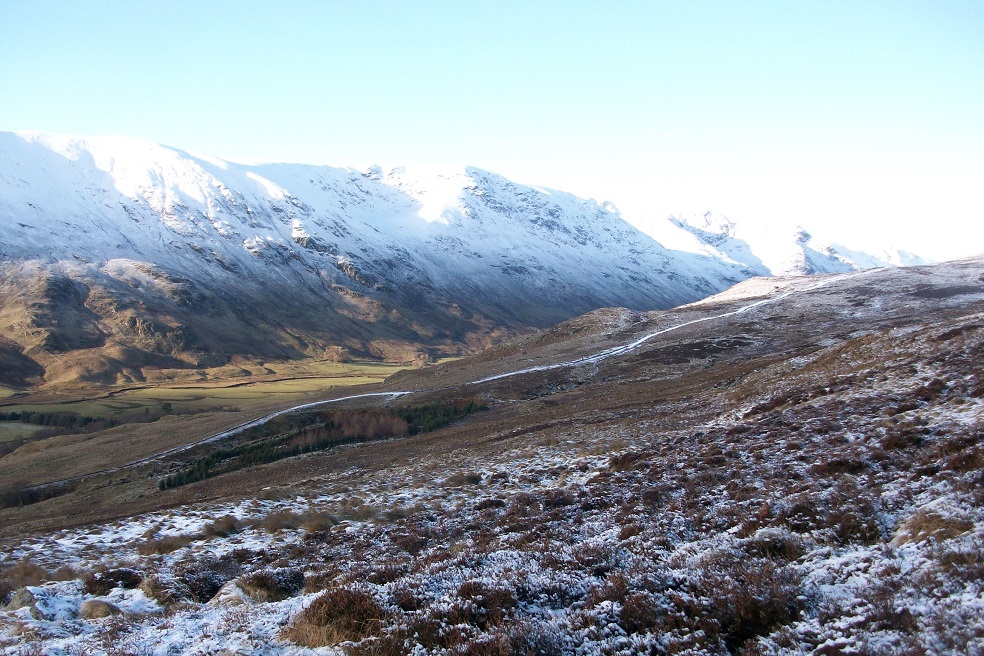
In December the LINK hill tracks group revealed that the owner of the Glen Clova estate, Mr Hugh Niven, has appealed to the Scottish Government against the enforcement notice which the Cairngorms National Park Authority issued against the new hill road by the Clova hotel (see here) and (here):
“It is deeply frustrating that a landowner is challenging the order forcing them to restore this unauthorised track, which is scarring the landscape in historic, protected Glen Clova.” (Extract from News Release).
Appeals are heard by a “Reporter” appointed by the Scottish Government’s DPEA (Planning and Environmental Appeals Division). 82 documents relating to the case (see here) were lodged prior to a site visit taking place on 20th December and the Reporter is due to issue her judgement by 17th January. This post takes a look about what they tell us about this critical case and the challenges that Planning Authorities face in controlling the proliferation of hill roads, not just in the Cairngorms National Park, but across Scotland.
Protection of the National Park landscape is dependant on the hill walking public
“CNPA officers first became aware of the red track on 11 May 2017 following a complaint from a member of the public. The complaint stated that a new track had been cut into the hillside and was highly visible from miles around. This was followed by a complaint by a member of the Ramblers Association who reported seeing a digger. Shortly thereafter, CNPA contacted the Appellant by e-mail requesting further information regarding the track and its planning status.”
By chance at the end of June 2017 I contacted the CNPA to report a number of tracks in Glen Prosen (see here) – which are still under investigation – and at the same time asked for information about the new road by the Glen Clova hotel. While I mistakenly thought that this was connected to the new Clova hydro scheme, the point is that concerns about the new road were being submitted to the CNPA from various sources. They were under pressure to act.
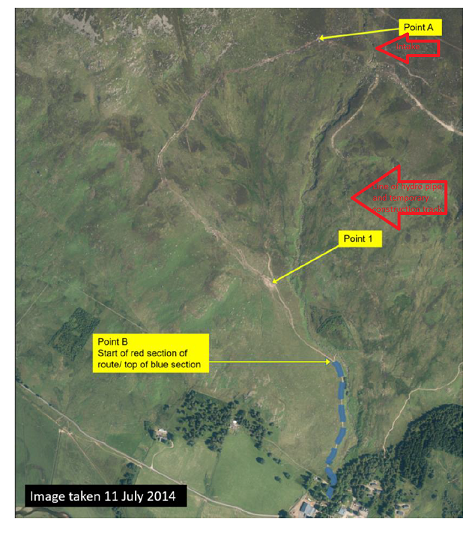
One wonders though why the CNPA had not picked up on the damage which was being done to the landscape previously? The planning consent for the Clova hydro scheme required the construction road to be fully restored- for which the CNPA should be congratulated – but its clear from the photos included in the Supporting Information for this appeal that soon after work was completed the Clova Estate started to drive vehicles up to the hydro intake by a different route. Unfortunately, judging by the junk which still lies abandoned at the first hydro intake (see here – again!) no member of planning staff was able to visit the scheme post completion to check that all planning conditions had been met. If they had done so, they would have been able to document what was going on and, had they acted, might have been able to forestall the ATV tracks being then “upgraded” into the new road:
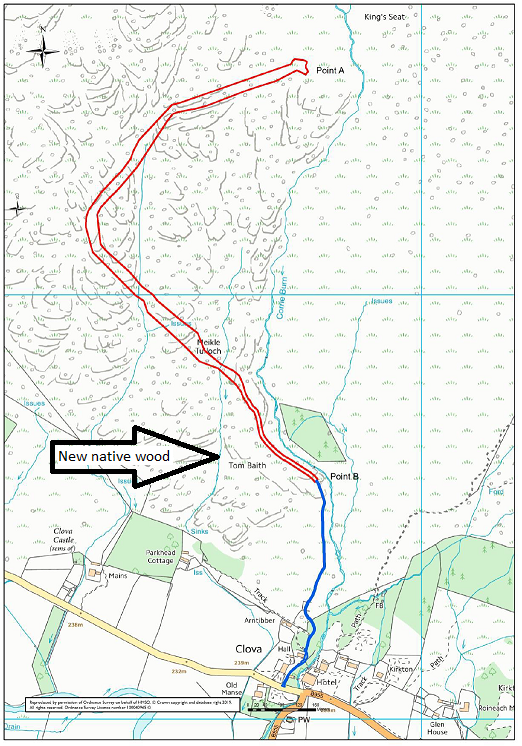
This failure of the planning system to monitor developments let alone what is going on in the wider countryside is revealed even more clearly by the dispute between the CNPA and the Clova Estate about when the new road was actually constructed. The Estate has tried to argue in their appeal that the road was in place before 15th December 2014, when the prior notification system for forestry and agricultural roads was introduced, and therefore did not need any form of planning permission. While Harper MacLeod LLP, acting on behalf of the CNPA, has done a good job exposing the inconsistencies and contradiction in the estate’s argument, the evidence about WHEN the road was constructed relies on ONE photo from a hillwalking blog from a member of the public:
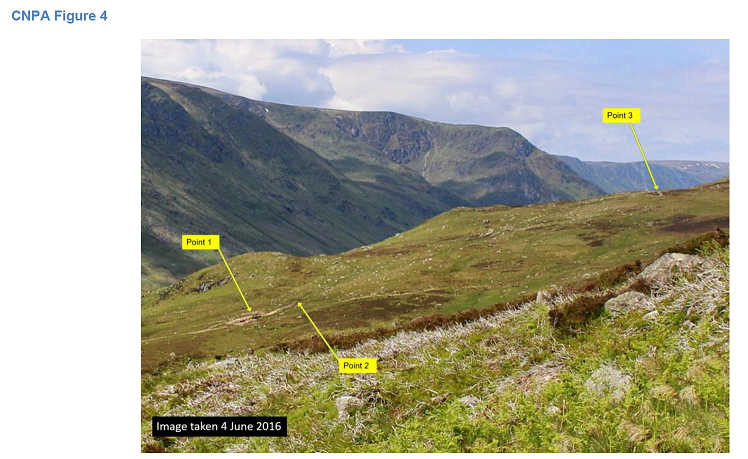
This photo disproved the claim made in the Glen Clova Estate’s appeal that:
“The construction of the track began in 2014 and was substantially completed by the summer of 2015”.
While its right that the CNPA has contested misinformation from the landowner, there is something very wrong with our planning system when it is reliant on the public to provide evidence of what is happening on the ground and to support subsequent enforcement action. The message to hill goers is take lots of photos and if you see something that looks bad, report it!
What the appeal shows about the role of the Cairngorms National Park Authority
While the CNPA acted promptly in response to the complaint and issued a Planning Contravention Notice (PCN), the appeal papers show that they only eventually issued an enforcement notice after various attempts to negotiate with Hugh Niven, the landowner had failed. Para 2.8 from the Supporting Information reads:
“Bearing in mind that (1) failure to comply without reasonable excuse with the requirements of a PCN and (2) knowingly or recklessly giving information in response to the notice which is false or misleading in a material particular can amount to criminal offences, the Appellant’s e-mail response of 20 June 2017 to the PCN (CNPA 16) was, at best, wholly inadequate. It didn’t provide any of the detailed information and evidence required by the PCN.”
Despite this failure to provide the required information, the CNPA then entered into dialogue with Hugh Niven in an attempt to get him to submit a retrospective planning application for the road along with appropriate measures to upgrade it to an appropriate standard. The Appeal Papers show Mr Niven failed to provide any documentation but in the Autumn claimed to have appointed a contractor to undertake unspecified restoration work and then that this restoration work had been carried out:
“The works were subsequently carried out by Carnegie Base Services, between 25th September 2017 and 4th October 2017 as detailed in their timesheet attached as Document 11″
The CNPA subsequently met with the contractor and could find no evidence of any work being undertaken. Evidence from my visit in February 2018 supports that contention:
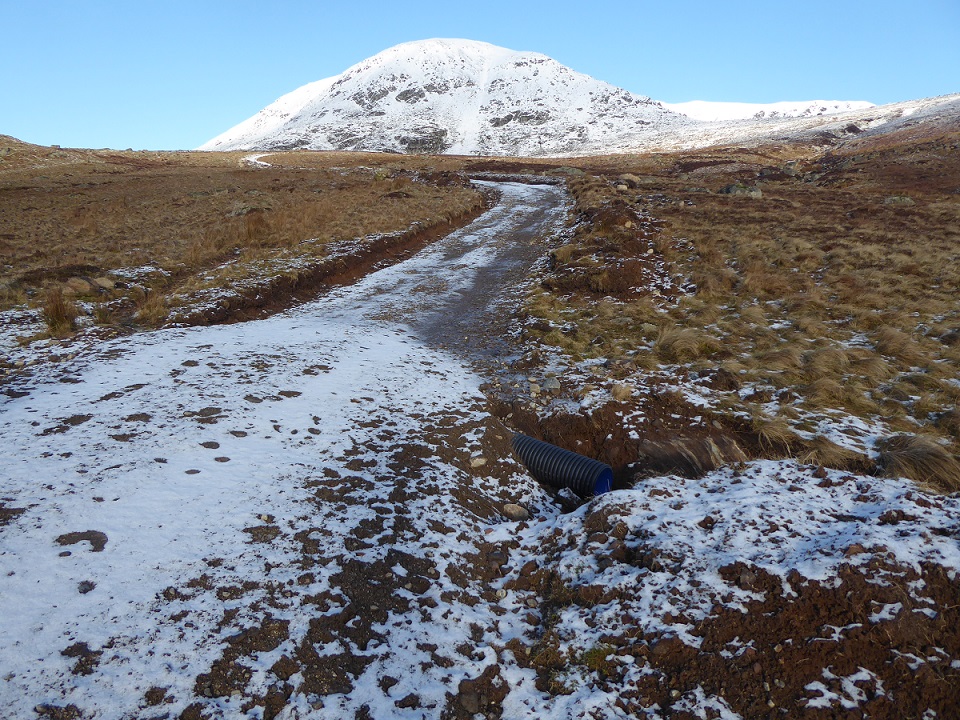
The CNPA had told the estate that if remedial work was undertaken, for example the road was narrowed to 2.5m wide with a central grass strip instead of 4-5 metres wide (as in photo above) and the piles of earth on either side re-landscaped, they would consider granting retrospective planning permission.
All communication from Mr Niven then appears to have ceased. Following a further site visit by CNPA staff in May 2018 the::
“CNPA contacted the Appellant in July 2018 in view of the lack of any apparent progress towards completion of remediation works and/or preparation/submission of an application for retrospective planning permission”.
There was then a “brief and inconclusive” meeting with Mr Niven in August in which he said that:
“he would apply for planning permission if he had to but would not remove the track”.
Nothing then appears to have happened until May 2019 when the CNPA decided to initiate enforcement action.
My conclusion from this is that the CNPA has ONLY taken enforcement action to remove what clearly appears to be an unlawful road because of the consistent failure by Mr Niven to co-operate over a period of almost two years. Had Mr Niven been prepared to submit a retrospective planning application, as has happened in other cases like Glen Banchor (see here), the past record of the CNPA shows that they would have almost certainly approved it even though this would have been in breach of their policy presumption against any new hill roads in the National Park.
Effectively, the message the CNPA as a Planning Authority is giving to landowners is that as long as they follow good practice design guidelines, they can still construct roads first and apply for planning permission afterwards. Mr Niven did neither, hence the enforcement action.
Enforcement secrecy
Unfortunately, the secretive manner in which the CNPA and other Planning Authorities approach planning enforcement matters appears to play into the hands of the landowners and developers as it keeps the public in the dark. An example is the decision to take enforcement action in this case. Agenda item 12 of the May 2019 CNPA Planning Committee (see here) is headed:
“Committee Authorisation of use of Planning Enforcement Powers
Oral Update
Gavin Miles, Head of Planning & Communities”
and the published minute states:
“Agenda Item 12:
Committee Authorisation of use of Planning Enforcement Powers
50. This item was discussed in closed session at the end of the meeting.”
However, the papers on the DPEA website reveal there was a WRITTEN paper (see here) submitted to the May Planning Committee which recommended enforcement action and also a very full minute. NEITHER of these have been published by the CNPA. If the DPEA believes that in terms of due legal process both documents should be made public, why not the CNPA?
The CNPA is, I believe, shooting itself in the foot here. Its appears so keen not to upset landowners that almost all dialogue and negotiations with them take place in private. This then allows landowners, as Mr Niven has done in his appeal, to claim they have NOT been properly consulted. If instead of this secretive private approach the CNPA were to record publicly all action taken to remedy planning breaches this would not just make the system more transparent, it would help prevent secret deals and empower the public to speak out.
It might also make it far easier for the public to complain about the glacial speed of planning enforcement processes.
A failure in cross compliance?
While the Glen Clova appeal papers provide insight into the consequences of the lack of resources available to planning authorities and the CNPA’s weak approach to planning enforcement, there also appears to have been a much wider failure on the part of public authorities to work together and protect the public interest. A search on the DEFRA Common Agricultural Policy payments website (see here) revealed that payments had been made in 2017 (the last year for which information is available) to TWO companies which appear linked with Hugh Niven.
First, Clova Farms Ltd, which lists Mr Niven as a Director:
I have been unable to establish (e.g from its accounts) whether Clova Farms Ltd carries out any business in Glen Clova but the payments made to the Clova Estate Ltd would appear to be for farming in the glen:
Its a moot question whether the payment for the “forest area development” relates to the new native woodland planting at the side of the new hill road (as illustrated on map above and photo below)?
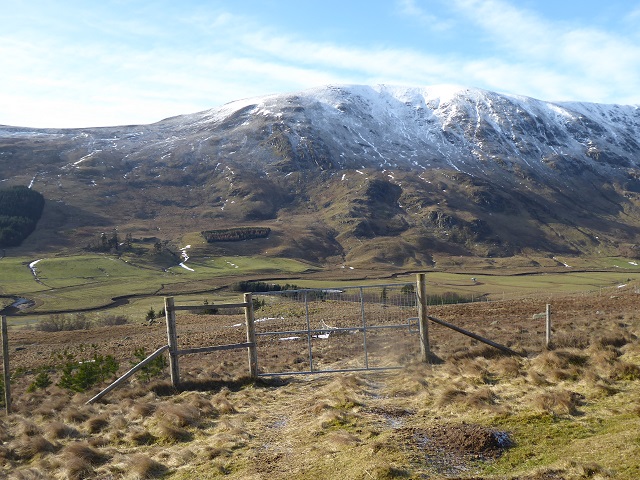
Among the various claims that Mr Niven makes in his appeal about the intended use of the new road, is it was needed for forestry purposes (and therefore didn’t require planning permission). If this new area of native woodland has been grant aided by the Scottish Rural Payments division, one might have expected that they would have checked on the status of the new hill road before agreeing to make any payment. Indeed, why didn’t Scottish Government officials insist that Mr Niven provided proper plans of how he intended to access the forestry and to submit a prior notification if a permanent new track was required? That never appears to have happened.
The public interest issue here is that the Scottish Government is forking out lots of public money to landowners – over £400k to Mr Niven in 2017 alone – to do things like plant trees or restore damaged peat in some areas (see here), while at the same time allowing them to continue to damage other areas of land they own and to ignore planning requirements.
This failure in consistency is something that the Scottish Government’s rules on “cross-compliance” (see here) were meant to stop. Unfortunately, at present these rules make no reference to the need to observe planning law, fail to mention roads or tracks (except to take care when cutting trees) and only refer to the need to protect landscape features like ponds and dry stane dykes, rather than the wider landscape as a whole. It really is time that the Scottish Government, and the responsible Minister Fergus Ewing, started to address this and BREXIT should provide the perfect opportunity as Scotland will no longer be bound by the rules of the Common Agricultural Policy.
What next?
Despite my reservations about the way the CNPA has handled the Glen Clova enforcement case they have, with the help of Harper MacLeod LLP, provided robust information for the appeal and I hope that the Reporter will find in their favour. That would provide a welcome warning to landowners that they cannot simply ignore the planning system, although as explained above I don’t think this case will be sufficient to deter many landowners from constructing new roads and then applying for planning permission retrospectively.
If it wins, the next step for the CNPA should be to take enforcement action against a landowner on the basis that a hill road is unaccepable, full stop. Until that happens landowners will continue to construct roads without applying for planning permission in the belief that they can get away with it.
If the CNPA loses, that would provide conclusive evidence that the current law on hill roads is NOT fit for purpose.
When last year the Scottish Government rejected Andy Wightman’s amendment (see here) to the Planning Bill, which would have brought hill roads fully into the planning system, they promised yet another review of how the current permitted development system was operating. That is due to take place this year. Whatever the outcome of the Glen Clova case, it should provide the Scottish Government with more evidence of the need to reform fundamentally the prior notification system and bring all new hill roads into the planning system. It also, I believe, shows that there are significant opportunities to strengthen the hand of our National Parks and other Planning Authorities by tightening up the rules on cross-compliance so that, for example, all rural payments are suspended to anyone who creates a new hill road or other damaging development without planning permission.
There are endless papers, reports and even books written over the last twenty years – including many from the UK government – exploring use of satellite remote imaging to monitor use and changes in national parks and other protected environmental areas. Given that I can even see hillside paths on free Google satellite images (and much better resolution is available for relatively small fees) it doesn’t seem at all impractical for planning compliance to be monitored remotely. In fact, with a bit of thought, it would be feasible to automatically cross reference the planning database and remote imaging to quickly highlight areas of concern that humans could then spend more time investigating. Which century are the national parks operating in?
Hi Andrew, I probably should have said that the CNPA decided to try and map all tracks using satellite imagery a couple of years ago, but this then got delayed. I am not sure if its finished yet but among the supporting documents for this appeal are some satellite images including one from 2014. For whatever reason there are not enough of these to narrow down the period when the track was constructed. Interestingly the appellant in their response to the CNPA claims that satellite images are NOT of good enough quality to be used as evidence – though the ones that exist do look clear to me. Nick
Let’s hope the Reporter sees sense and makes her decision in favour of CNPA, otherwise estate landowners will just do whatever they want with hill tracks.
I have much personal experience of repeated lack of enforcement of planning conditions by CNPA – even knowingly permitting a developer to breach a planning condition which was in place to protect neighbouring property. Additionally I concur with the Glen Clova evidence, that in my experience CNPA often fails to check on planning compliance and relies too much on interested members of the public informing them – even in cases where the development is almost on CNPA’s planning office doorstep.
As in the Glen Clova case, CNPA too often relies on developer’s or their consultants’ reports to satisfy themselves that planning conditions have been complied with and can be discharged. It took me 3 months to convince CNPA that a SUDS pond had been incorrectly constructed and overrule a consultant’s email that the SUDS pond had been constructed to drawing. A two minute visit with drawing in hand would have shown up the problem.